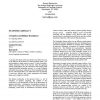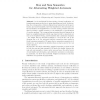50 search results - page 7 / 10 » A Particular Universal Cellular Automaton |
SASO
2008
IEEE
14 years 1 months ago
2008
IEEE
—When programming a spatial computing medium such as a cellular automaton, the hop count distance to some set of sources (particles) is an often used information. In particular, ...
STOC
2010
ACM
14 years 4 months ago
2010
ACM
We close affirmatively a question which has been open for long time: decidability of the HOM problem. The HOM problem consists in determining, given a tree homomorphism D and a re...
COMGEO
2011
ACM
12 years 10 months ago
2011
ACM
ABSTRACT . Categories and Subject Descriptors K. Computing Milieux K.m MISCELLANEOUS General Terms Theory Keywords Cyber-physics, Internet of Things, Quantum computing Cloud Comput...
ATVA
2011
Springer
12 years 6 months ago
2011
Springer
Abstract. In the traditional Boolean setting of formal verification, alternating automata are the key to many algorithms and tools. In this setting, the correspondence between dis...
ISVD
2007
IEEE
14 years 1 months ago
2007
IEEE
The spatial cosmic matter distribution on scales of a few up to more than a hundred Megaparsec1 displays a salient and pervasive foamlike pattern. Voronoi tessellations are a vers...


